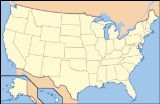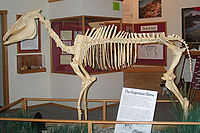
Hagerman Fossil Beds National Monument
Encyclopedia
Hagerman Fossil Beds National Monument near Hagerman
, Idaho
, contains the largest concentration of Hagerman Horse
fossils in North America. The fossil horses for which the Monument is famous have been found in only one locale in the northern portion of the Monument called the Hagerman Horse Quarry
. The 4,351-acre (17.6 km2) Monument is internationally significant because it protects the world's richest known fossil deposits from a time period called the late Pliocene
epoch, 3.5 million years ago. These plants and animals represent the last glimpse of that time that existed before the Ice Age
, and the earliest appearances of modern flora and fauna. This is also significant because the fossils present during this period of the Pliocene represent species which were alive during the early stages in the evolution of man, albeit on a different continent.
Many other species are also found in the fossil record, such as mastodon
, dirk tooth cat, bone crushing dog (Borophaginae
), as well as various species of fish, frog, vole and beaver.
Hagerman, Idaho
Hagerman is a town in Gooding County, Idaho, United States. The population was 768 at the 2007 census.-Geography:Hagerman is located at .According to the United States Census Bureau, the city has a total area of , all of it land....
, Idaho
Idaho
Idaho is a state in the Rocky Mountain area of the United States. The state's largest city and capital is Boise. Residents are called "Idahoans". Idaho was admitted to the Union on July 3, 1890, as the 43rd state....
, contains the largest concentration of Hagerman Horse
Hagerman Horse
The Hagerman horse , also called the Hagerman zebra or the American zebra, was a North American species of equid from the Pliocene period and the Pleistocene period. It was one of the oldest horses of the genus Equus. Discovered in 1928 in Hagerman, Idaho, it is believed to have been like the...
fossils in North America. The fossil horses for which the Monument is famous have been found in only one locale in the northern portion of the Monument called the Hagerman Horse Quarry
The Hagerman Horse Quarry
The Hagerman Horse Quarry is a paleontological site containing the largest concentration of Hagerman Horse fossils yet found. The quarry is within Hagerman Fossil Beds National Monument, located west of Hagerman, Idaho, USA, at the geographic division of the Snake River Plain...
. The 4,351-acre (17.6 km2) Monument is internationally significant because it protects the world's richest known fossil deposits from a time period called the late Pliocene
Pliocene
The Pliocene Epoch is the period in the geologic timescale that extends from 5.332 million to 2.588 million years before present. It is the second and youngest epoch of the Neogene Period in the Cenozoic Era. The Pliocene follows the Miocene Epoch and is followed by the Pleistocene Epoch...
epoch, 3.5 million years ago. These plants and animals represent the last glimpse of that time that existed before the Ice Age
Ice age
An ice age or, more precisely, glacial age, is a generic geological period of long-term reduction in the temperature of the Earth's surface and atmosphere, resulting in the presence or expansion of continental ice sheets, polar ice sheets and alpine glaciers...
, and the earliest appearances of modern flora and fauna. This is also significant because the fossils present during this period of the Pliocene represent species which were alive during the early stages in the evolution of man, albeit on a different continent.
 |
 |
Notable fossil species
- Hagerman HorseHagerman HorseThe Hagerman horse , also called the Hagerman zebra or the American zebra, was a North American species of equid from the Pliocene period and the Pleistocene period. It was one of the oldest horses of the genus Equus. Discovered in 1928 in Hagerman, Idaho, it is believed to have been like the...
, Equus simplicidens, formerly known as Plesippus shoshonensis - CamelopsCamelopsCamelops is an extinct genus of camels that once roamed western North America, where it disappeared at the end of the Pleistocene about 10,000 years ago. Its name is derived from the Greek κάμελος + , thus "camel-face."-Background:...
, An extinct species of camel that once inhabited North America
Many other species are also found in the fossil record, such as mastodon
Mastodon
Mastodons were large tusked mammal species of the extinct genus Mammut which inhabited Asia, Africa, Europe, North America and Central America from the Oligocene through Pleistocene, 33.9 mya to 11,000 years ago. The American mastodon is the most recent and best known species of the group...
, dirk tooth cat, bone crushing dog (Borophaginae
Borophaginae
The subfamily Borophaginae is an extinct group of canids called "bone crushing dogs" that were endemic to North America during the Oligocene to Pliocene and lived roughly 36—2.5 million years ago and existing for approximately .-Origin:...
), as well as various species of fish, frog, vole and beaver.

